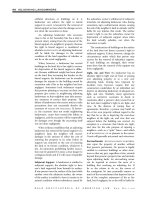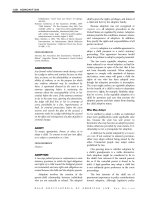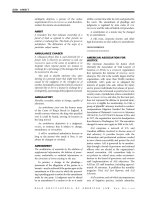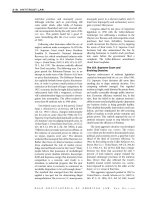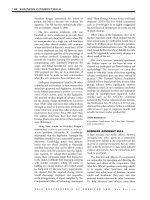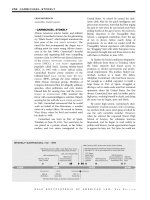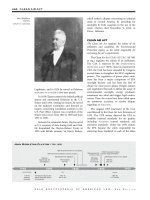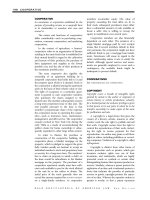Gale Encyclopedia Of American Law 3Rd Edition Volume 5 P28 potx
Bạn đang xem bản rút gọn của tài liệu. Xem và tải ngay bản đầy đủ của tài liệu tại đây (565.17 KB, 10 trang )
these two combine, they form an entirely new
thesis, or synthesis. (3) This synthesis is the
beginning of a new series of developments.
Hegel believed that life eternally fo rms itself by
setting up oppositions.
Hegel’s system has special implications for
the progress of history, particularly the evolu-
tion of people and government. He believed
that the ideal universal soul can be created
through logic that is based on his dialectic. This,
he argued, was the foundation of all develop-
ment. Using his three-part dialectic, he laid out
the development of society. Hegel’s thesis was
that the primary goal of persons is to acquire
property, and the pursuit of property by all
persons necessitates the antithesis of this goal,
laws. The association of persons and laws
produces a synthesis, called ethos, that com-
bines the f reedom and interdependence of the
people and creates a state. According to Hegel,
the state is above the individual. Allowed to
reach its highest form of development, Hegel
believed, the state evolves into a monarchy (a
government ruled by a single person, often
called a king or queen).
Hegel’s view of government is at odds with
the historical course pursued by the United
States. In fact, he was a critic of the individual-
ism at the heart of the American Revolution.
But his ideas have nonetheless had an immea-
surable effect on modern thought in the United
States as well as Europe. He saw human history
as the progression from bondage to freedom,
attainable only if the will of the individual is
made secondary to the will of the majority. This
view shaped the development of the philosophy
of idealism in the United States and Europe.
Hegel’s dialectic was also adapte d by
KARL MARX
as the basis for Marx’s economic theory of the
struggle of the working class to achieve revolu-
tion over the owners of the means of produc-
tion. In the twentieth century, Hegel inspired
the academic methodology called deconstruc -
tionism, used in fields ranging from literature to
law as a means to in terpret texts.
Although Hegel was largely ignored or
attacked by U.S. legal scholars for two centuries,
the 1950s brought a new interest in his ideas
that has grown in the ensuing decades.
Generally speaking, scholars have examined
his work for its views on liberalism and the
concepts of freedom and responsibility. Hegeli-
an thought has been used to address everything
from historical problems such as
SLAVERY to
Georg Hegel.
LIBRARY OF CONGRESS.
Georg Wilhelm Friedrich Hegel 1770–1831
❖
1770 Born,
Stuttgart,
Germany
1788–93
Studied
theology at
University of
Tübingen
1807 The
Phenomenology
of the Mind
published
1818 Appointed professor at University of Berlin
1831 Died,
Berlin, Germany
▼▼
▼▼
17751775
18251825
18501850
18001800
1775–83
American Revolution
1812–14
War of 1812
1821 Philosophy of
Right published
◆
1817 Encyclopedia of the Philosophical Sciences published
❖
◆
1793–1800
Worked as
tutor in Bern
and Frankfurt
am Main
1802–03 Edited the Critical Journal of
Philosophy with Friedrich Schelling
1808–16
Headed the
Gymnasium in
Nuremberg
1812–16 Science of Logic published
◆◆◆
1816 Appointed professor at University of Heidelberg
GALE ENCYCLOPEDIA OF AMERICAN LAW, 3RD E DITION
258 HEGEL, GEORG WILHELM FRIEDRICH
contemporary issues in contracts, property,
torts, and CRIMINAL LAW. It has also influenced
the
CRITICAL LEGAL STUDIES movement.
FURTHER READINGS
Althaus, Horst. 2000. Hegel: An Intellectual Biography.
Michael Tarsh, trans. Cambridge, UK: Polity.
Carlson, David Gray. 1999–2000. “How to Do Things with
Hegel.” Texas Law Review 78 (May).
———. 1992. “The Hegelian Revival in American Legal
Discourse.” Univ. of Miami Law Review 46 (March).
Hegel, Georg. 1977. The Difference between Fichte’s and
Schelling’s System of Philosophy. Translated by H.S.
Harris and Walter Cerf. Albany, NY: State Univ. of New
York Press.
Hoffheimer, Michael H. 1995. “Hegel’s First Philosophy of
Law.” Tennessee Law Review 62 (summer).
McCracken, Chad. 1999. “Hegel and the Autonomy of
Contract Law.” Texas Law Review 77 (February).
Pinkard, Terry. 2001. Hegel: A Biography. Cambridge; New
York: Cambridge Univ. Press.
CROSS REFERENCE
Jurisprudence.
HEIGHTENED SCRUTINY
Heightened scrutiny is a standard of judicial
review for a challenged law or policy in which the
court presumes the law to be invalid unless the law
furthers an important government interest in a
way that is substantially related to that interest.
Heightened scrutiny is also known as
intermediate scrutiny because it is the middle
level of three tests develop ed by the Supreme
Court to decided constitutional questions. The
lowest level of constitutional review is the
RATIONAL BASIS TEST, whereas the highest level is
the
STRICT SCRUTINY test. The outcome of a case
where constitutional arguments are made often
depends on which level of review is applied. The
Supreme Court has identified issues that quali fy
for one of these three tests.
The least rigorous of the three, the rational
basis test, is employed in cases where a
PLAINTIFF
alleges that the legislature has made an arbitrary
or irrational decision. Plaintiffs rarely succeed
because this test gives great deference to the
legislative branch. The legislature’s reasons for
enacting a law may be misguided or clearly
wrong, but as long as the body did not act
arbitrarily, the Court will not overturn statutes
on constitutional grounds.
The most rigorous test is called strict
scrutiny. The Supreme Court has mandated that
courts apply strict scrutiny when fundamental
rights are at issue. The Court has identified
the right to vote, the right to travel, and the
right to privacy as fundamental rights. In
addition, when a law or policy makes distinc-
tions based on a
SUSPECT CLASSIFICATION, strict
scrutiny must be appli ed. Race, national origin,
alienage, and religious affiliation are suspect
classifications. However, gender, age, and dis-
ability are not. Unlike rational basis, the
government has the burden of proving that
the suspect law is narrowly tailored and the
least restrictive means to further a compelling
government interest.
Heightened scrutiny was developed by the
Supreme Court to deal with classifications that
did not, in the Court’s view, reach the level of
race and other suspect classifications. The test
was announced in Craig v. Boren (429 U.S., 97
S. Ct. 451, 50 L.Ed.2d 397 [1976]). Boren dealt
with an Oklahoma law that treated women
differently than men. Because the Court was
unwilling to make gender a suspect classifica-
tion but did not believe rational basis was the
proper standard of review, it came up with
heightened scrutiny.
The law prohibited the sale of “nonintoxi-
cating” 3.2 beer to males under the age of 21 but
permitted females over the age of 18 to buy it.
The law was challenged as discriminatory under
the
EQUAL PROTECTION clause of the FOURTEENTH
AMENDMENT
by three plaintiffs: two men, who
were over 18 but under 21, and a female beer
vendor. In a 7–2 vote with four co ncurring
opinions, the Court ruled that the law was
unconstitutional. Oklahoma attempted to show
the legislature had a rational basis for enacting a
law it believed would reduce drunk driving. It
provided statistics showing that arrests of males
18 to 20 years of age outnumbered those of
females of similar age by a factor of nine for
“drunk” driving (2 percent versus 18 percent),
by a factor of eighteen for “drivi ng under the
influence,” and by a factor of ten for public
drunkenness.
Justice William Brennan, in his majority
opinion, announced that gender-based classifi-
cations were subject to a higher level of scrutiny
than provided by the rational basis test. For the
law to survive, the state would have to show that
classifying by gender “must serve important
governmental objectives and must be substan-
tially related to those objectives.” This test was
somewhat less rigorous than strict scrutiny.
GALE ENCYCLOPEDIA OF AMERICAN LAW, 3RD E DITION
HEIGHTENED SCRUTINY 259
Justice Brennan applied the test to the facts
of the case and concluded the law was
unconstitutional. He agreed that the state had
an important government interest in keeping
people from driving while intoxicated. The
statistical evidence demonstrated that there
was a problem with underage drinking and
driving, but it failed to show that the law was
“substantially related to those objectives.”
The heightened or intermediate scrutiny t est
has been applied to a number of gender-based
classifications. In Mississippi University for Wom-
en v. Hogan (458 U.S. 718, 102 S. Ct. 3331; 73 L.
Ed. 2d 1090), the Supreme Court held that the
single-sex admission policy of a Mississippi
University violated the equal protection clause.
In this case, an otherwise qualified male nursing
school candidate was denied admission because
of his gender. Mississippi did have two coeduca-
tional schools of nursing, but he would have had
to relocate because of they were in other parts of
the state. The federal district court used the
rational basis test, ruling that maintaining the
nursing school as a single-sex school had a
rational relationship to the state’s legitimate
interest “in providing the greatest practical range
of educational opportunities for its female
student population.” In addition, the single-sex
policy was not arbitrary. The Supreme Court
applied the heightened scrutiny test and conclud-
ed that the state had an important government
interest in providing educational options for all
its residents. However, the single-sex admission
policy was not substantially related to that
interest. The Court noted that there must be an
“exceedingly persuasive justification” for gender-
based classification to be judged constitutional.
Heightened scrutiny has also been applied
to legal restrictions based on illegitimacy. In
Caban v. Mohammed (441 U.S. 380, 99 S. Ct.
1760, 60 L. Ed. 2d 297 [1979]), the state of New
York had a law that only allowed mothers to
block adoptions of children born out of
wedlock, regardless of the relationship between
the children and the natural father. In this case,
the unwed mother and father lived together for
five years and had two children. The father
acknowledged paternity on the birth certificate.
When the couple later separated, the mother
retained custody of the children, but the father
visited the children regularly. When the mother
married another man, the husband sought
to adopt the children. The father opposed
the adoption, but the trial court granted the
adoption based on the best interests of the
children.
The Supreme Court ruled that the law
violated the equal protection clause because the
father had a relationship with the children fully
comparable to that of the mother. The law was
unequal because the mother had an absolute
veto over an out-of-wedlock child, whereas the
father was required to prove that it was in the
best interest of the child for the child not to be
adopted. The state could not give the mother an
absolute veto, while forcing the father to show
child’s best interest before he could retain
parental rights.
FURTHER READINGS
Flack, Horace Edgar. 2003. The Adoption of the Fourteenth
Amendment. Birmingham, Ala.: Palladium Press.
Langran, Robert. 2003. The Supreme Court: A Concise
History. New York: Peter Lang.
Tribe, Lawrence. 2008. The Invisible Constitution. New York:
Oxford Univ. Press.
CROSS REFERENCES
Rational Basis Test; Strict Scrutiny; Suspect Classification.
HEIR
An individual who receives an interest in, or
ownership of, land, tenements, or hereditaments
from an ancestor who has died intestate, through
the laws of descent and distribution. At common
law, an heir was the individual appointed by law
to succ eed to the estate of an ancestor who died
without a will. It is commonly used in the early
2000s in reference to any individual who succeeds
to property, either by will or law.
An heir of the body is an heir who was either
conceived or born of the individual who has
died, or a child of such heir. This ty pe of heir is
anyone who descends lineally from the dece-
dent, excluding a surviving spouse, adopted
children, and collateral relatives. Ordina rily,
property can be given by will to anyone named
or can be shared by all heirs, but historically, the
owner of an entail could only pass his or her
property on to heirs of the body. This type of
inheritance is largely abolished by statute in the
early twenty-first century.
HELD
In relation to the opinion of a court, decided.
The holding in a particular case is the
ultimate decision of a court of a justiciable
controversy.
GALE ENCYCLOPEDIA OF AMERICAN LAW, 3RD E DITION
260 HEIR
v
HELMS, JESSE ALEXANDER, JR.
The career of Jesse Alexander Helms Jr. is
unique in post-World War II U.S. politics. Few
legislators have fought as relentlessly, caused as
much uproar, or arguably, had as much
influence as the ultraconservative Republican
from North Carolina. As a fiery radio editorialist
in the 1960s, Helms waged a one-man war on
liberalism. His notoriety helped him win a
historic 1972 Senate race, a breakthrough in a
state that had not elected a Republican in the
twentieth century, and three reelections fol-
lowed. He emerged not only as a party leader
but as an independent legislator with his own
tough agenda on social issues and foreign policy.
Born October 18, 1921, in the small
segregated town of Monroe, North Carolina,
Helms was named for his formidable fathe r.
JESSE HELMS Sr. was the town’s police and fire
chief, and he exacted obedience from Monroe
and his two sons alike. “My father was a six-
foot, two-hundred pound gorilla,” Helms
affectionately said. “When he said, ‘Smile,” I
smiled.” His mother, Ethel Mae Helms, mar-
shaled her fam ily off to the First Baptist Church
twice a week. In Helms’s childhood, Monroe
still romantically celebrated Confederate Me-
morial Day, and patriotism, regional pride,
RELIGION, and racial separation were formative
influences on the boy. He showed early promise
in writing, by high school already reporting for
the local newspaper.
Journalism held such interest for Helms that
he quit Wake Forest College in 1939 to work on
the Ral eigh News and Observer. The 20-year-old
moved up rapidly. By 1941 he was assistant city
editor of the Raleigh Times, the city’s smaller,
more conservative paper. Then Pearl Harbor
intervened. Accepted by the U.S. Navy for
limited duty in recruitment and public speak-
ing, Helms made a crucial discovery: he was
good at broadcasting. Starting in 1948, he began
a new career as a radio news director at station
WRAL in Raleigh.
Helms soon moved from the role of political
observer to that of political insider. His
reporting in the vicious, racially divided 1950
Democratic primary race for the Senate led to
accusations that he had doctored a photo of the
wife of the loser, Frank Graham, so that she
appeared to be dancing with a black man—a
fatal blow to the cand idate’s chances in the
segregated state. Helms denied it. The winner,
Jesse Alexander Helms Jr. 1921–2008
▼▼
▼▼
1925
2000
1975
1950
◆
◆◆❖◆
◆
◆◆
◆
◆
◆
❖
1921 Born,
Monroe, N.C.
1939 Left Wake Forest
College to join editorial
staff of Raleigh News
and Observer
1939–45
World War II
1942–45
Served in
U.S. Navy
1948 Hired as radio news
director at WRAL in Raleigh
1951 Became administrative
assistant to Senator Willis Smith
1950–53
Korean War
1957–61
Served on
Raleigh
City
Council
1960–72
Served as
officer of
Capital
Broadcasting
Company
1976 When
Free Men
Shall Stand
published
1984 Established
new record—
$16.5 million—
for Senate
campaign
fundraising
in his reelection
race against
Jim Hunt
1990 Won tough reelection
campaign against Harvey Gantt
1994
Elected
chair
of the
Senate
Foreign
Relations
Committee
2000
Accused
United
Nations
of not
respecting
U.S.
sovereignty
1972–2002 Represented
North Carolina in U.S. Senate
1961–73
Vietnam War
2001 September 11
terrorist attacks
2008 Died,
Raleigh,
N.C.
2005 Here’s Where I Stand published
Jesse Helms.
U.S. SENATE HISTORICAL
OFFICE
GALE ENCYCLOPEDIA OF AMERICAN LAW, 3RD E DITION
HELMS, JESSE ALEXANDER, JR. 261
Senator Willis Smith, took him to Washington
as his administrative assistant in 1951. Working
in the Senate propelled Helms closer to a
political career.
From 1953 to 1960 Helms was a lobbyist
and editorialist for the North Carolina Bankers
Association. He had an opportunity to exercise
his poli tics in a weekly column and at the same
time held his first elective office, on the Raleigh
City Council, where, although nominally a
Democrat, he opposed virtually all taxes.
The great turning point in Helms’s life came
in 1960. As the executive vice president of the
Capital Broadcasting Company, he began
broadcasting fierce radio editorials on radio
station WRAL. Here, for the next 12 years, he
developed views that would last the rest of his
life. These broadcasts were fire and brimstone.
In much the same way that radio host Rush
Limbaugh criticized liberals in the 1990s, Helms
attacked liberal trends in the 1960s. He referr ed
to the 1960s as “this time of the fast buck and
the ‘New Morality’—the age of apathy and
indifference, the season of disdain for simple
virtues and common honesty.”
What riled Helms most was the
CIVIL RIGHTS
MOVEMENT
. Carried across the state of North
Carolina, Helms’s attacks on desegregation were
reprinted in newspapers under such titles as
“Nation Needs to Know of Red Involvement in
Race Agitation!” The liberal media were to
blame, Helms reasoned, and if they would stop
distorting the truth, then “there would be
millions around the world who would change
their minds about race relations in the South.”
Despite his own biases, Helms and WRAL
survived repeated complaints to the
FEDERAL
COMMUNICATIONS COMMISSION
.
It was only a matter of time before the
conservative Helms gave up on the
DEMOCRATIC
PARTY
. In 1972, he switched parties and ran for
the U.S. Senate as a Republican. Helms liked to
tell his radio listeners that he had never voted
for a Democrat for president, and now, with the
decidedly liberal George S. McGovern as the
Democratic nominee, he had even more reason
to sever his symbolic ties to the party.
McGovern stood for everything that Helms
detested: support for welfare and
ABORTION, and
opposition to the war in Vietnam. To Helms,
such views were typical of the way liberalism
betrayed traditional values, and why he could
not remain a Democrat.
When Helms jumped ship, he took an
extreme gamble. North Carolina— indeed, the
South as a whole—had been the Democratic
Party’s stronghold for generations. In fact, not
since the late nineteenth century had the state
elected a Republican senator. Helms changed
everything. One key to his beating the favorite,
Democrat Nick Galifianakis (by only 120,000
votes), was Helms’s use of national politics. The
presidential election offered excellent coattails
upon which to ride. Helms allied himself with
Republican candidate
RICHARD M. NIXON, linking
Galifianakis with the highly unpopular McGo-
vern. Galifianakis saw a much different, and
worse, kind of tarring at work. He accused the
Helms campaign of using his Greek American
ethnicity to imply that he was not a loyal U.S.
citizen.
Not surprisingly, Helms’s first term in
Washington, D.C., established the same hard-
line politics of his broadcasting career. He was
soon nicknamed Senator No for voting against
federal spending—with the exception of sup-
port for the military and farmers. He opposed
federal aid to education, food stamps for
striking workers, government-subsidized abor-
tion, and the creation of the
CONSUMER PROTEC-
TION
Agency.
Returning politics to traditional values
would be the hallmark of his career, a philoso-
phy outlined in his 1976 book, When Free Men
Shall Stand. During his first term in the U.S.
Senate, he introduced an amendment designed
to circumvent the Supreme Court’s decisions
banning prayer in public schools. Although the
effort failed, it paid personal dividends: Helms
came to the attention of conservative organiza-
tions and contrib utors who would be increas-
ingly supportive of him over the next two
decades. He saw no conflict with his faith in
opposing government aid to the needy. He
believed it was the role of the private individual
to help others, as he and his wife, Dorothy
Helms, had done by adopting a nine-year-old
orphan with cerebral palsy. In Congress he
voted against federal aid to disabled people and
against school lunch programs.
Unlike some social conservatives, Helms had
an equal passion for foreign policy. He was
staunchly anti-communist, a belief that formed
the basis for his opposition to any cooperation
between the United States and left-wing govern-
ments. He opposed President Nixon’s historic
opening of ties to China. Supporting right-wing
WE ARE LIVING IN
AN AGE WHERE
ANYTHING GOES
.
—JESSE HELMS
GALE ENCYCLOPEDIA OF AMERICAN LAW, 3RD E DITION
262 HELMS, JESSE ALEXANDER, JR.
governments—even those associated with
abuses of HUMAN RIGHTS, such as Turkey, or with
all-white rule, such as Rhodesia and South
Africa—made more sense to him.
Helms gained influence as his career pro-
gressed. By the late 1970s he was already
shaping the Republican presidential platform
behind the scenes. In Senate votes, he could
openly defy the party on nomina tions and
policy decisions. Helms had little fear of the
party leadership because he was building a
national base of support. He did this with the
help of a powerful insider in national politics,
Richard A. Viguerie, publisher of the Conserva-
tive Digest. Viguerie was an early advocate of
using direct-mail techniques, a marketing tool
borrowed from business. As campaign manager
for Helms in 1978, he blanketed the United
States with letters asking fo r support. It worked,
fantastically. Helms raised $6.2 million for his
successful 1978 reelection, two-thirds of it from
outside of North Carolina. Politicians of all
kinds soon followed his lead in using this
powerful technology.
In the 1980s the importance of direct mail
to Helms grew in proportion to the rise of
conservative Christian politics. Analysts called
this emerging constituency the New Right. It
favored mandating school prayer, outlawing
abortion, and preventing gays and lesbians from
acquiring equal rights. Helms tapped its mem-
bers with dramatic fund-raising letters. By 1982,
Helms could count on great support for brash,
independent actions in the Senate: filibustering
against the renewal of the Voting Rights Act, for
example, or attaching a school prayer amend-
ment to the annual extension of the natio nal
debt.
The 1980s was a period of great activity for
Helms in domestic policy. He railed against the
National Endowment for the Arts (NEA) for
funding art that he found offensive, chiefly that
of the gay photographer Robert Mapplethorpe
and of the artist Andres Serrano, whose work
Piss Christ depicted a crucifix submerged in
urine. The national controversy he engen dered
continued to divide liberals and conservatives
well into the 1990s. He also led a highly
publicized attempt to take over CBS, exhorting
conservatives to buy up stock in o rder to end
liberal bias in news reporting. He introduced
antiabortion legislation that made him the leading
enemy of pro-abortion forces, which began
demonizingHelmsintheirowndirect-mail
campaigns. He was most successful in
agriculture policy. Helms won continued back-
ing for tobacco price supports, an issue key to
one of his most active advocates, the tobacc o
industry.
In a combative 1990 reelection campaign,
Helms nearly lost to African American Harvey
Gantt. The former Democratic mayor of
Charlotte was ahead of Helms until the last
weeks of the campaign, when Helms’s forces
mailed 125,000 postcards to voters warning
them that they could be prosecuted for
FRAUD if
they voted improperly. At least 44,000 cards
were sent to black voters, according to the U.S.
DEPARTMENT OF JUSTICE, which sent observers to
the state to ensure fair elections. Helms edged
out Gantt by just over 100, 000 votes. In 1992
the
JUSTICE DEPARTMENT ruled that the Helms
campaign had violated federal
CIVIL RIGHTS and
voting laws by intimidating, threatening, and
discouraging African Americans from voting.
Helms’s office denied that he was involved in
the mailings.
Helms was an outspoken critic of President
BILL CLINTON. The Republican takeover of
Congress in November 1994 gave him chair-
manship of the Foreign Relations Committee, a
powerful post from which he could authorize
money for foreign aid, make recommendations
on ambassadors and foreign treaties, and
control the budget of the
STATE DEPARTMENT.
Almost immediately, he blasted the president as
unfit to conduct foreign policy and warned
that Clinton “better have a bodyguard” if he
planned to visit North Carolina military bases.
Politicians from both parties denounced the
remark, which came on the anniversary of the
ASSASSINATION of President JOHN F. KENNEDY.
Helms called his statement a “mistake,” but
refused to apologize.
Despite surgery for serious health problems,
Helms seemed eager to enter more battles. He
was reelected to another term in 1996, again
defeating Harvey Gantt. He served on the
Foreign Relations Committee until 2001. Dur-
ing his tenure as chair, the committee approved
143 treatises (although some were later rejected
or returned to the president), confirmed 477
presidential nominations for ambassadorships
and other administrative posts, and conducted
597 hearings.
In 2001, after serving on the Senate for 30
years, Helms announced that he would not seek
reelection in the 2002 elections. He continued,
GALE ENCYCLOPEDIA OF AMERICAN LAW, 3RD E DITION
HELMS, JESSE ALEXANDER, JR. 263
however, to spark controversy even in the final
year of his term as senator. He allegedly made
some racially charged comments to the press, not
dissimilar to those made by Senator
TRENT LOTT at
the birthday celebration of Senator Strom
Thurmond. (These comments eventually cost
Lott his position as Senate majority leader).
Helms also openly criticized the lifestyles of
homosexuals. Nevertheless, many conservatives
celebrated his numerous accomplishments prior
to his retirement in 2003. And no one could
deny the indelible imprint he left on U.S. politics.
Helms supported Elizabeth Dole, wife of
former Senator Bob Dole, as his successor in
the 2002 senatorial election in North Carolina.
Dole won a heated race in the nation’s most
expensive congressional campaign.
Helms married the former Dorothy Jane
Coble in 1942, with whom he had three
children and seven grandchildren. They were
longtime cerebral palsy advocates, and were
actively involved with the Jesse Helms Center in
Wingate, North Carolina. The nonprofit center
promotes free enterprise, representative democ-
racy, and traditional values.
Here’s Where I Stand, which came out in
2005, is Helms’s memoir of his life, his ideological
positions, and his political career. He died on July
4, 2008.
FURTHER READINGS
Furgurson, Ernest B. 1996. Hard Right: The Rise of Jesse
Helms. New York: Norton.
The Jesse Helms Center. Available online at www.
jessehelmscenter.org (accessed August 18, 2009).
Snider, William D. 1985. “Helms & Hunt: The North
Carolina Senate Race, 1984.” Chapel Hill, N.C.: Univ.
of North Carolina Press.
Wagner, John. 2003. “Helms Looks Back.” The News &
Observer (January 3).
CROSS REFERENCES
Election Campaign Financing; Republican Party.
HENCEFORTH
From this time forward.
The term henceforth, when used in a legal
document, statute, or other legal instrument,
indicates that something will commence from
the present time to the future, to the exclusion
of the past.
v
HENRY II OF ENGLAND
King Henry II was born March 5, 1133, in Le
Mans, France. He reigned from 1154 to 1189
and founded the Plantagenet dynasty of English
Henry II of England 1133–1189
▼▼
▼▼
11251125
12001200
11751175
11501150
1133 Born,
LeMans, France
1150 Became Duke
of Normandy
1152 Became Duke of Aquitaine after
marriage to Eleanor of Aquitaine
1153 Invaded England in quest
to unseat King Stephen
1154 Recognized as
lawful successor to
the throne; crowned
king of England,
founded Plantagenet
dynasty
1164
Convocation
at Clarendon;
Archbishop
of Canterbury,
Thomas Becket,
fled to France
1170 Becket murdered
in Canterbury cathedral
1171 Invaded
and annexed
Ireland
1188
Glanvill's
Tractatus
first
appeared
1189 Died,
near Tours, France
1180 Ranulf
Glanvill
appointed
chief justiciar
of England
◆◆◆ ◆ ◆ ◆ ◆◆◆
❖
❖
Henry II of England.
LIBRARY OF CONGRESS
GALE ENCYCLOPEDIA OF AMERICAN LAW, 3RD E DITION
264 HENCEFORTH
rulers. Henry’s many innovations in civil and
CRIMINAL PROCEDURE had a lasting effect upon
ENGLISH LAW and his expansion of the royal court
system made royal justice available throughout
England.
Building upon the earlier tradition of the
inquest, Henry issued several assizes, or ordi-
nances, that introduced the procedures that
eventually developed into the
GRAND JURY.He
also developed a number of w rits to bring cases
from the feudal courts of the barons into the
royal courts. In addi tion, Henry sent itinerant
justices on regular circuits through the kingdom
to make royal justice more easily obtainable.
Henry’s expansion of royal justice did, how
ever, bring him into conflict with
THOMAS
BECKET
, the archbishop of Canterbury, w ho
opposed the king’s efforts to pu nish members
of the clergy who had been convicted of crimes
in
ECCLESIASTICAL COURTS and removed from their
clerical status. Becket was murdered in 1170
by some of the king’s men, though apparently
not at his command, and Henry thereafter
gave up his efforts to punish members of the
clergy. Henry died July 6, 1189, near Tours,
France.
v
HENRY, PATRICK
Patrick Henry was a leading statesman and
orator at the time of the American Revolutionary
War. Several of Henry’sspeecheshaveremained
vivid documents of the revolutionary period,
with “Give me liberty or give me death” his most
remembered statement.
Henry was born May 29, 1736, in Hanover
County, Vi rginia. Though Henry attended
public school for a short time, he was largely
taught by his father, who had a good education.
From 1751 to 1760 Henry was a storekeeper
and farmer. When his business and farming
ventures failed, he turned to the study of law,
and received his license to practice in 1760.
Within three years Henry had become a
prominent attorney, owing in great measure to
his oratorical skills. He was drawn to politics,
and was elected to the Virginia House of
Burgesses in 1765. In this colonial legislature,
Henry became an outspoken criti c of British
policies toward the 13 colonies. He introduced
Patrick Henry 1736–1799
❖
❖
1736 Born,
Hanover County, Va.
1799 Elected to
Va. legislature;
died, Red Hill, Va.
1760
Admitted to
Virginia bar
1774 Became member of the Virginia Provincial
Convention when House of Burgesses dissolved
1765 Elected to Va. House of Burgesses;
led effort to repeal Stamp Act
1766 Stamp
Act repealed
1788 Attended
Va. convention
for the
ratification of
U.S. Constitution;
advocated
addition of the
Bill of Rights
1775–83
American Revolution
▼▼
▼▼
17751775
18001800
17251725
17501750
1751–60 Worked
as storekeeper
and farmer
◆
◆◆ ◆◆
◆
◆
1773 Joined
Jefferson and Lee
to form the
Committee of
Correspondence
1774–75 Attended First
and Second Continental
Congresses
1794 Retired to
Red Hill, Va.
1776–79 and
1784–86 Served as
governor of Virginia
Patrick Henry.
AP/WORLD WIDE PHOTOS
GALE ENCYCLOPEDIA OF AMERICAN LAW, 3RD E DITION
HENRY, PATRICK 265
seven resolutions against the STAMP ACT, which
levied a tax by requiring that stamps be affixed
to documents and other papers. In one speech
opposing the act, he stated, “If this be
TREASON,
make the most of it.”
Henry’s efforts led the Virginia House of
Burgesses to pass five of the seven resolutions he
introduced. All seven resolutions were reprinted
in newspapers as the Virginia Resolves. Colonial
businesspeople, in support of the resolves,
agreed not to import British goods until the
Stamp Act was repealed. Trade diminished, and
business owners refused to use the stamps on
business documents. Faced with organized
resistance in the colonies, and the displeasure
of British businesses that had lost trade, the
British Parliament repealed the Stamp Act on
March 4, 1766.
Henry grew more radical after the repeal of
the act, arguing that the colonies should break
away from Great Britain. In 1773 he joined with
THOMAS JEFFERSON and Richard Henry Lee
to form the Committe e of Correspondence
to transmit messages throughout the colonies.
When the House of Burgesses was dissolved in
1774 he became a member of the Virginia
Provincial Convention, which advocated revo-
lution. Before this convention, he made his
most famous remarks, words that became the
clarion call that led the colonies into revolution:
“I know not what course others may take, but as
for me, give me liberty or give me death.”
During 1774 and 1775 Henry attended the
First
CONTINEN TAL CONGRESS as a member of
the Virgin ia delegation, advocating military
mobilization. When the Second Continental
Congress convened in 1775, he helped draft
the legislation that organized the Contine ntal
Army. In 1776 he also helped draft the Virginia
Constitution.
In 1776 Henry was elected governor of the
newly independent commonwealth of Virginia.
A tireless administrator, Henry worked vigor-
ously to meet the demands of the Revolutionary
War. As commander in chief, he recruited the
state’s quota of 6,000 men for the Continental
Army, plus the state militia’s allotment of five
thousand soldiers.
After the war, Henry continued as governor,
eventually serving five terms. During his second
term, Henry provided supplies to George Rogers
Clark for his expedition to the Northwest
Territory. Clark rid the territory of British
control.
In 1788 Henry attended the Virginia
convention for the ratification of the U.S.
Constitution. Henry opposed ratification, fear-
ing that it imperiled the rights of states and
individuals, but Virginia ratified it. Henry
successfully advocated the addition of the
BILL
OF RIGHTS
to the document. This first ten
amendments to the Constitution protec t the
rights of states and individuals, allowing Henry
to support the Constitution.
Following ratification, Henry was offered
many government posts, but was forced to
resume his Virginia law practice to rescue
himself from personal debt. He quickly became
a wealthy man , because his fame attracted many
clients. In 1794 he retired to his estate at Red
Hill, near Appomattox, Virginia. Despite his
new wealth, Henry refused pleas to resume
public service, turning down President George
Washington’s request to serve as chief justice of
the U.S. Supreme Court.
Washington finally persuaded Henry to seek
election to the Virginia legislature. Henry won
election in 1799. He died June 6, 1799, before
he could take office.
FURTHER READINGS
Mayer, Henry. 2001. A Son of Thunder: Patrick Henry and
the American Republic. New York: Grove.
Rivkin, Victoria. 1998. “Patrick Henry.” New York Law
Journal 220 (August 24): 4.
Wirt, William. 2009. Sketches of the Life and Character of
Patrick Henry. Carlisle, MA: Applewood.
HEREAFTER
In the future.
The term hereafter is always used to indicate
a future time—to the exclusion of both the past
and present—in legal documents, statutes, and
other similar papers.
HEREDITAMENT
Anything that can be passed by an individual to
heirs.
There are two types of hereditaments: cor-
poreal and incorporeal.
A corporeal heredi tament is a permanent
tangible object that can be seen and handled
and is confined to the land. Materials, such as
coal, timber, stone, or a house are common
examples of this type of hereditament.
THE BATTLE, SIR, IS
NOT TO THE STRONG
ALONE
; IT IS TO THE
VIGILANT
, THE
ACTIVE
, THE BRAVE.
—PATRICK HENRY
GALE ENCYCLOPEDIA OF AMERICAN LAW, 3RD E DITION
266 HEREAFTER
An incorporeal hereditament is an intangible
right, which is not visible but is derived from
real or
PERSONAL PROPERTY. An easement is a
classic example of this type of hereditament,
since it is the right of one individual to use
another’s property and can be inherited.
HERITAGE FOUNDATION
The HERITAGE FOUNDATION is a research and
educational institute, popularly kno wn as a
“think tank,” whose mission is to formu late and
promote conservative public policies based on
the principles of free enterprise, limited govern-
ment, individual freedom, traditional values,
and a strong national defense. Founded in 1973,
the Heritage Foundation has proven to be
effective, gaining nation al influence during the
administrations of Presidents
RONALD REAGAN
and GEORGE H.W. BUSH. This influence grew in
the 1990s, as conservative Republicans gained
control of Congress in 1994. Speaker of the
House
NEWT GINGRICH of Georgia declared just
after the 1994 election, “Heritage is, without
question, the most far-reaching conservative
organization in the country in the war of ideas,
and one which has had a tremendous impact
not just in Washington, but literally across the
planet.”
The Heritage Foundation is a nonpartisan,
tax-exempt institution and is governed by an
independent board of trustees. It relies on the
private financial support of individuals, founda-
tions, and corporations for its income and
accepts no government funds and performs no
contract work. Currently it receives support
from more than 200,000 contributors. Its
headquarters are in Washington, D.C.
The staff of the Heritage Foundation includes
policy and research analysts who examine issues
in a wide variety of fields, including the legislative
and executive branches of government, domestic
policy, education, corporations, foreign policy,
the
UNITED NATIONS, Asian studies, and other
areas of public concern. Once the researchers
have made their findings, the foundation markets
the results to its primary audiences: members
of Congress, key congressional staff members,
policy makers in the
EXECUTIVE BRANCH,the
news media, and the academic and policy
communities.
The Heritage Foundation publicizes its
work through weekly, monthly, and quarterly
periodicals, including Policy Review. It also
provides public speakers to promote its posi-
tions and convenes conferences and meetings
on policy issues.
The Heritage Foundation has playe d an
important role in advancing conservative ideas,
especially after the election of Republican
majorities in the U.S. House of Representatives
and S enate in 1994. The Republican “Contract
with America” agenda sought major changes in
the size and power of the federal government.
Heritage Foundation staff played a key role
behind the scenes in helping to craft and refine
legislative proposals. The overhaul of the
system of agricultural subsidies and the first
comprehensive rewriting of the telecommuni-
cations law embraced free-market approaches
advocated by the foundation. Its research and
proposals also shaped the 1996 welfare reform
bill. This was followed by a period of intensive
fund-raising and recruitment of members in
such initiatives as the Leadership for America
campaign. This activity led to the Heritage
Foundation e xceeding its two-year goal of
$85 million in donations. In 2001 the H eritage
Foundation actively supported a program of
sweeping federal tax reforms that were eventu-
ally signed into law by President
GEORGE W.
BUSH.
FURTHER READINGS
Berkowitz, Bill. 2008. “The Heritage Foundation at 35.”
(March 3).
The Heritage Foundation. Available online at http://www.
heritage.org (accessed July 29, 2009).
“The Think Tank Index.” 2009. Foreign Policy.
CROSS REFERENCE
Lobbying.
HIERARCHY
A group of people who form an ascending chain of
power or authority.
Officers in a government, for example, form
an escalating series of ranks or degrees of power,
with each rank subject to the authority of the
one on the next level above. In a majority of
hierarchical arrangements, there are a larger
number of people at the bottom than at the top.
Originally, the term was used to mean
government by a body of priests. Currently, a
hierarchy is used to denote any body of
individuals arranged or classified according to
capacity, authority, position, or rank.
GALE ENCYCLOPEDIA OF AMERICAN LAW, 3RD E DITION
HIERARCHY 267
